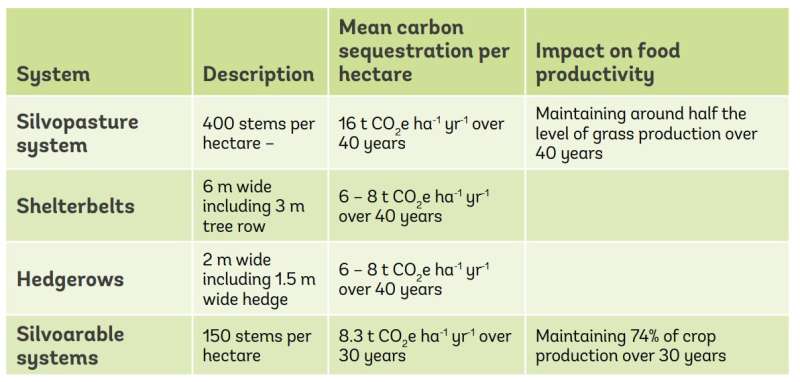Report examines how agroforestry can deliver for nature and the climate

Agroforestry—farming with trees—could be pivotal in helping the agricultural sector reach net zero by 2050, according to new research carried out by Cranfield University, which underpins a report by the Woodland Trust.
The Cranfield research explains that agriculture is responsible for 10% of UK territorial greenhouse gas emissions with the net effect of "land use, land use change and forestry" responsible for another 1%.
In order to meet net zero targets for 2050, the report says it is essential that farm businesses implement practices to reduce their greenhouse gas emissions, which may typically amount to around two to four tons of carbon dioxide equivalent per hectare per year on arable and grassland farms respectively. In comparison, the average per capita emission of a UK citizen is about eight tons of CO2 equivalent per year.
One way to offset greenhouse gas emissions is to increase the area of tree cover on farms using agroforestry. Using models and experimental results, the research shows that growing trees alongside crops (known as silvoarable agroforestry) could lock up eight tons of CO2 equivalent per hectare per year over 30 years. A silvopastoral system, where 400 trees per hectare were planted on grassland, was predicted to lock up 16 tons of CO2 equivalent per year over 40 years.
Assuming no other reduction in agricultural emissions, establishing agroforestry on 20 percent of arable land and 30%of grassland could enable UK agriculture-related emissions to reach net zero by 2050 whilst maintaining high levels of food production. Integrating trees into farming systems can also provide benefits for wildlife, enhance soil health, and moderate runoff and water flows. It can also lead to enhancement of other ecosystems services including pest control in organic systems, and pollination.
Paul Burgess, Professor of Sustainable Agriculture and Agroforestry at Cranfield University, who conducted the research with Dr. Anil Graves, Senior Lecturer in Land Use Systems, said, "consumers and retailers increasingly want their food derived from farms with zero or negative greenhouse gas emissions and increased tree planting (agroforestry) is one of the few ways that farm businesses can maintain food production whilst achieving net zero targets over the next 30 years. Because the carbon sequestration of newly planted trees is initially slow, planting needs to occur now to achieve targets for 2050."
The report is timely given the Government is anticipated to outline its plans for the future of farming and land management policy in early November.
Abi Bunker, Director of Conservation and External Affairs at the Woodland Trust said, "this new research shows just how much good that having more trees within our farmed landscapes could bring, not just in terms of making important contribution to tackling climate change and helping reverse biodiversity declines, but also in supporting farm businesses to adapt to climate change and become more resilient to the types of financial, social and environmental shocks that are likely to be a part of the future."
More information: Report: www.woodlandtrust.org.uk/publi … ming-for-the-future/
Provided by Cranfield University




















